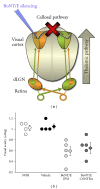The corpus callosum and the visual cortex: plasticity is a game for two
- PMID: 22792494
- PMCID: PMC3388387
- DOI: 10.1155/2012/838672
The corpus callosum and the visual cortex: plasticity is a game for two
Abstract
Throughout life, experience shapes and selects the most appropriate brain functional connectivity to adapt to a changing environment. An ideal system to study experience-dependent plasticity is the visual cortex, because visual experience can be easily manipulated. In this paper, we focus on the role of interhemispheric, transcallosal projections in experience-dependent plasticity of the visual cortex. We review data showing that deprivation of sensory experience can modify the morphology of callosal fibres, thus altering the communication between the two hemispheres. More importantly, manipulation of callosal input activity during an early critical period alters developmental maturation of functional properties in visual cortex and modifies its ability to remodel in response to experience. We also discuss recent data in rat visual cortex, demonstrating that the corpus callosum plays a role in binocularity of cortical neurons and is involved in the plastic shift of eye preference that follows a period of monocular eyelid suture (monocular deprivation) in early age. Thus, experience can modify the fine connectivity of the corpus callosum, and callosal connections represent a major pathway through which experience can mediate functional maturation and plastic rearrangements in the visual cortex.
Figures


Similar articles
-
Influence of ocular dominance columns and patchy callosal connections on binocularity in lateral striate cortex: Long Evans versus albino rats.J Comp Neurol. 2020 Mar 1;528(4):650-663. doi: 10.1002/cne.24786. Epub 2019 Oct 18. J Comp Neurol. 2020. PMID: 31606892 Free PMC article.
-
Functional masking of deprived eye responses by callosal input during ocular dominance plasticity.Neuron. 2009 Dec 10;64(5):707-18. doi: 10.1016/j.neuron.2009.10.019. Neuron. 2009. PMID: 20005826
-
Callosal contribution to ocular dominance in rat primary visual cortex.Eur J Neurosci. 2010 Oct;32(7):1163-9. doi: 10.1111/j.1460-9568.2010.07363.x. Epub 2010 Aug 19. Eur J Neurosci. 2010. PMID: 20726891
-
Activity-dependent development of interhemispheric connections in the visual cortex.Rev Neurosci. 2008;19(1):19-28. doi: 10.1515/revneuro.2008.19.1.19. Rev Neurosci. 2008. PMID: 18561818 Review.
-
Lifelong learning: ocular dominance plasticity in mouse visual cortex.Curr Opin Neurobiol. 2006 Aug;16(4):451-9. doi: 10.1016/j.conb.2006.06.007. Epub 2006 Jul 11. Curr Opin Neurobiol. 2006. PMID: 16837188 Review.
Cited by
-
Neural Correlates of Sensory Eye Dominance in Human Visual White Matter Tracts.eNeuro. 2022 Nov 23;9(6):ENEURO.0232-22.2022. doi: 10.1523/ENEURO.0232-22.2022. Print 2022 Nov-Dec. eNeuro. 2022. PMID: 36347601 Free PMC article.
-
In Vivo Evaluation of White Matter Integrity and Anterograde Transport in Visual System After Excitotoxic Retinal Injury With Multimodal MRI and OCT.Invest Ophthalmol Vis Sci. 2015 Jun;56(6):3788-800. doi: 10.1167/iovs.14-15552. Invest Ophthalmol Vis Sci. 2015. PMID: 26066747 Free PMC article.
-
Interhemispheric plasticity is mediated by maximal potentiation of callosal inputs.Proc Natl Acad Sci U S A. 2019 Mar 26;116(13):6391-6396. doi: 10.1073/pnas.1810132116. Epub 2019 Mar 7. Proc Natl Acad Sci U S A. 2019. PMID: 30846552 Free PMC article.
-
Reorganization of Visual Callosal Connections Following Alterations of Retinal Input and Brain Damage.Front Syst Neurosci. 2016 Nov 14;10:86. doi: 10.3389/fnsys.2016.00086. eCollection 2016. Front Syst Neurosci. 2016. PMID: 27895559 Free PMC article. Review.
-
Deafferentation-induced plasticity of visual callosal connections: predicting critical periods and analyzing cortical abnormalities using diffusion tensor imaging.Neural Plast. 2012;2012:250196. doi: 10.1155/2012/250196. Epub 2012 Nov 8. Neural Plast. 2012. PMID: 23213572 Free PMC article. Review.
References
-
- Berlucchi G, Aglioti S, Marzi CA, Tassinari G. Corpus callosum and simple visuomotor integration. Neuropsychologia. 1995;33(8):923–936. - PubMed
-
- Innocenti GM, Aggoun-Zouaoui D, Lehmann P. Cellular aspects of callosal connections and their development. Neuropsychologia. 1995;33(8):961–987. - PubMed
-
- Gazzaniga MS. Cerebral specialization and interhemispheric communication. Does the corpus callosum enable the human condition? Brain. 2000;123(7):1293–1326. - PubMed
-
- Tomasch J. Size, distribution, and number of fibres in the human corpus callosum. The Anatomical Record. 1954;119(1):119–135. - PubMed
-
- Bloom JS, Hynd GW. The role of the corpus callosum in interhemispheric transfer of information: excitation or inhibition? Neuropsychology Review. 2005;15(2):59–71. - PubMed
Publication types
MeSH terms
LinkOut - more resources
Full Text Sources

